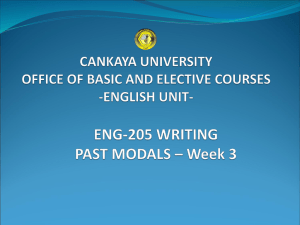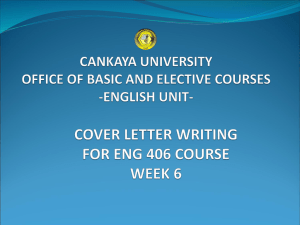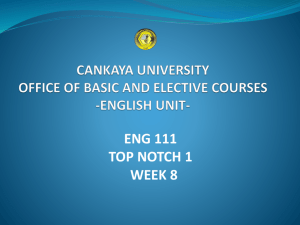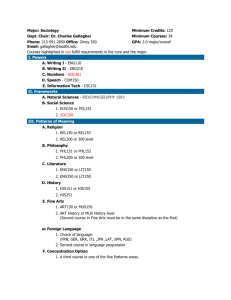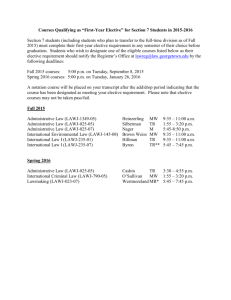REPORT TYPES
advertisement
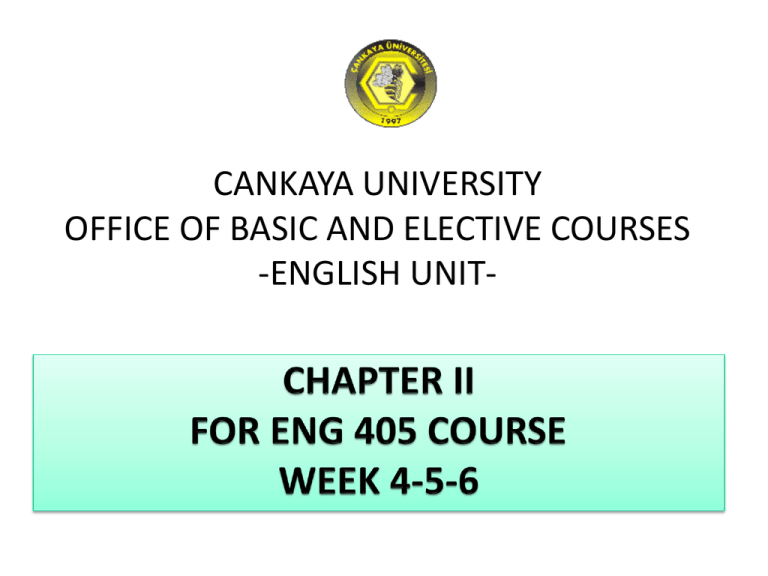
CANKAYA UNIVERSITY OFFICE OF BASIC AND ELECTIVE COURSES -ENGLISH UNIT- CHAPTER II TYPES of REPORTS OUTLINE 1. 2. 3. 4. Report Basics Organizational Patterns for Reports Report Formats Formality of Reports CANKAYA UNIVERSITY - OFFICE OF BASIC AND ELECTIVE COURSES- ENGLISH UNIT REPORT TYPES Report Basics Basic Categories of Reports on the Basis of Their Functions Informative reports offer data, facts, feedback, and other types of Business Plans, information, without analysis or recommendation. Practicum Reports, Progress Report, Lab Reports, Manuals, Brochures Analytical reports offer both information and analysis, and they can also Market Analysis Reports, include recommendations. Troubleshooting Reports, Feasibility Reports, Justification Reports Proposals offer structured persuasion for internal or external Grant Proposals, audiences. Investment Proposals, Sales Proposals, General Project Proposals CANKAYA UNIVERSITY - OFFICE OF BASIC AND ELECTIVE COURSES- ENGLISH UNIT REPORT TYPES Organizational Patterns for Reports The reader’s expectations and the content of a report determine its pattern of development. CANKAYA UNIVERSITY - OFFICE OF BASIC AND ELECTIVE COURSES- ENGLISH UNIT REPORT TYPES Direct vs. Indirect Pattern DIRECT INDIRECT when the purpose is presented close to the beginning When the reader is familiar with the topic Introductionfacts/findings/conclusions/recomme ndations – summary When the conclusions & recommendations appear at the end when readers are unfamiliar with the problem when readers must be persuaded when they may be disappointed in or hostile toward the report’s findings Introduction or description of the problem- factsinterpretation - conclusions and recommendations CANKAYA UNIVERSITY - OFFICE OF BASIC AND ELECTIVE COURSES- ENGLISH UNIT REPORT TYPES Report Formats 1. Letter Format Use letter format for short (usually 8 or fewer pages) informal reports addressed outside an organization. Prepared on a company’s letterhead stationery, a letter report contains a date, inside addresses, salutation, and complimentary close CANKAYA UNIVERSITY - OFFICE OF BASIC AND ELECTIVE COURSES- ENGLISH UNIT REPORT TYPES Report Formats 2. Memo Format For short informal reports that stay within organizations memo format is appropriate. Memo reports begin with essential background information, using standard headings: Date, To, From, Subject. Like letter reports, memo reports differ from regular memos in length, use of headings, and deliberate organization CANKAYA UNIVERSITY - OFFICE OF BASIC AND ELECTIVE COURSES- ENGLISH UNIT REPORT TYPES Report Formats 3. Manuscript Format For longer, more formal reports use manuscript format. These reports are usually printed on plain paper instead of letterhead stationery or memo forms. They begin with a title followed by systematically displayed headings and subheadings. Proposals and formal reports use manuscript format. CANKAYA UNIVERSITY - OFFICE OF BASIC AND ELECTIVE COURSES- ENGLISH UNIT REPORT TYPES Report Formats 4. Printed Forms Prepared forms are often used for repetitive data, such as monthly sales reports, performance appraisals, merchandise inventories, expense claims, and personnel and financial reports. Standardized headings on these forms save time for the writer. Preprinted forms also make similar information easy to locate and ensure that all necessary information is provided. CANKAYA UNIVERSITY - OFFICE OF BASIC AND ELECTIVE COURSES- ENGLISH UNIT REPORT TYPES Report Formats 5. Digital Format Some reports are not primarily meant to be printed but will be projected or viewed and edited digitally. Increasingly, businesses encourage employees to upload reports to the company intranet. Firms provide software enabling workers to update information about their activities, progress on a project, and other information about their on-the-job performance. CANKAYA UNIVERSITY - OFFICE OF BASIC AND ELECTIVE COURSES- ENGLISH UNIT REPORT TYPES Formality of Reports REPORTS informal reports informative internal formal reports analytical external CANKAYA UNIVERSITY - OFFICE OF BASIC AND ELECTIVE COURSES- ENGLISH UNIT REPORT TYPES Formality of Reports The type of report you write depends highly on the purpose, audience, and scope of the information. If you are writing a report for your manager, you may provide the information about the latest antivirus program for your company benefits via an informal, analytical, and at the same time, internal report. if you are trying to sell your new antivirus program to companies, you write a formal, informative, and external report. CANKAYA UNIVERSITY - OFFICE OF BASIC AND ELECTIVE COURSES- ENGLISH UNIT REPORT TYPES Informal Reports Informal reports tend to be short (usually eight or fewer pages), use memo or letter format, and are personal in tone. Much of the writing done in industry and technical fields fall into the informal report category. Although the objectives and preparatory steps that apply to formal and informal reports are similar, the components of informal reports are less extensive, the structure is more flexible. Informal reports are usually brief (less than 10 pages) and usually take the form of letter or memo. Sometimes, as in the case of accident, trip, or expense reports, these documents are prepared ob a standard, preprinted form. CANKAYA UNIVERSITY - OFFICE OF BASIC AND ELECTIVE COURSES- ENGLISH UNIT REPORT TYPES Informal Reports Information reports Progress reports Justification / Recommendation reports Feasibility reports Minutes of meetings Summaries Trip reports Brief Analysis reports Laboratory reports CANKAYA UNIVERSITY - OFFICE OF BASIC AND ELECTIVE COURSES- ENGLISH UNIT REPORT TYPES Informal Reports Informal reports have 5 basic elements, arranged in a fairly standard form. 1. 2. 3. 4. 5. Introduction Summary Background Conclusions & Recommendations Discussion CANKAYA UNIVERSITY - OFFICE OF BASIC AND ELECTIVE COURSES- ENGLISH UNIT REPORT TYPES Formal Reports Formal reports discuss the results of a process of thorough investigation and analysis. Formal reports are different from informal reports in length, organization, and serious tone. They represent the product of thorough investigation and analysis. They present organized information to decision makers in business, industry, government, and education. Although formal reports in business are seen infrequently, they serve an important function. They provide management with vital data for decision making. As a part of company’s decision-making process, formal reports communicate with many people: executive and management personnel, senior engineers, perhaps legal and financial officers, and other whose areas will be affected by the decision. CANKAYA UNIVERSITY - OFFICE OF BASIC AND ELECTIVE COURSES- ENGLISH UNIT REPORT TYPES Formal Reports Formal reports discuss the results of a process of thorough investigation and analysis. Formal reports are usually lengthy (10 or more pages) and often adhere to a precise format and well-defined structure. They are often designed to build a case carefully and to argue its conclusions and recommendations. The tone of a formal report is objective; there is no evidence of the “you” attitude here. CANKAYA UNIVERSITY - OFFICE OF BASIC AND ELECTIVE COURSES- ENGLISH UNIT REPORT TYPES Formal Reports The Basic Elements of a Formal Report Cover Title Page Letter of Transmittal Table of Contents List of Illustrations Glossary List of symbols Executive Summary or Abstract Introduction Body Conclusions Recommendations References Appendices formal reports have more elements than informal reports because they are more detailed and longer documents. You need to direct the readers as the writer to have an impact on the readers. In formal reports, you have more personal or practical reasons to persuade the readers, such a selling your product, signing a contract, raising a fund for your project, or starting a business. CANKAYA UNIVERSITY - OFFICE OF BASIC AND ELECTIVE COURSES- ENGLISH UNIT REPORT TYPES 1. Information Reports Reports that collect and organize information are informative or investigative They may record routine activities such as daily, weekly, and monthly reports of sales or profits. They may investigate options, performance, or equipment. Although they provide information, they do not analyze that information. CANKAYA UNIVERSITY - OFFICE OF BASIC AND ELECTIVE COURSES- ENGLISH UNIT REPORT TYPES 1. Information Reports information reports provide information without drawing conclusions or making recommendations. Some information reports are highly standardized, such as police reports, hospital admittance reports, monthly sales reports, or government regulatory reports. Information reports generally contain three parts: introduction, body (findings), and conclusion. The body may have many subsections. CANKAYA UNIVERSITY - OFFICE OF BASIC AND ELECTIVE COURSES- ENGLISH UNIT REPORT TYPES 1. Information Reports Suggestions For Writing Information Reports Explain why you are writing in the introduction. Describe what methods and sources were used to gather information and why they are credible. Provide any special background information that may be necessary. Preview what is to follow. Organize the facts/findings in a logical sequence. Consider grouping the facts/findings in one of these patterns: (a) chronological, (b) alphabetical, (c) topical, (d) geographical, (e) journalism style (who, what, when, where, why and how), (f) simple-to-complex, or (g) most to least important. Summarize your findings, synthesize your reactions, and suggest action to be taken, or express appreciation in the conclusion. CANKAYA UNIVERSITY - OFFICE OF BASIC AND ELECTIVE COURSES- ENGLISH UNIT REPORT TYPES 2. Trip Reports One distinct type of information report is the trip report. business travelers identify the event they attended or the company they visited objectively summarizes three to five main points and, if requested, itemizes their expenses on a separate sheet. Trip reports inform management about new procedures, equipment, trends, and laws or regulations. They may supply information affecting products, operations, and service. CANKAYA UNIVERSITY - OFFICE OF BASIC AND ELECTIVE COURSES- ENGLISH UNIT REPORT TYPES 2. Trip Reports A good trip report includes an introduction, information about the specific concerns of the readers, and information on topics of general interest to the company. You should provide: As much relevant, specific information as possible The significance of those specifics for your company. CANKAYA UNIVERSITY - OFFICE OF BASIC AND ELECTIVE COURSES- ENGLISH UNIT REPORT TYPES 3. Progress Reports Progress reports monitor the headway of unusual or nonroutine activities. For example, progress reports would keep management informed about a committee’s preparations for a trade show 14 months from now. Such reports usually answer three questions: Is the project on schedule? Are corrective measures needed? What activities are next? (How are you doing?) (What have you done?) (What are you going to do next?) CANKAYA UNIVERSITY - OFFICE OF BASIC AND ELECTIVE COURSES- ENGLISH UNIT REPORT TYPES 3. Progress Reports Continuing projects often require progress reports to describe their status. These reports may be external (telling customers how their projects are advancing) or internal (informing management of the status of activities). If it is only a few pages long, write the progress report in a letter or memo format. CANKAYA UNIVERSITY - OFFICE OF BASIC AND ELECTIVE COURSES- ENGLISH UNIT REPORT TYPES 3. Progress Reports Elements included in a progress report are: Introduction Project description: Briefly describe the work being done, stating the purpose and scope. Work Completed: Tell what you have accomplished to date. Work Planned for Future Periods: Tell what you expect to accomplish in the future: your goals, expected outcomes, and schedule. Appraisal of Progress: Evaluate your progress. Indicate where you are ahead of schedule and where you are behind. If there are good reasons as to why the work is not going according to plan, state them clearly. CANKAYA UNIVERSITY - OFFICE OF BASIC AND ELECTIVE COURSES- ENGLISH UNIT REPORT TYPES 3. Progress Reports Suggestions For Writing Progress Reports Specify in the opening the purpose and nature of the project. Provide background information if the audience requires filling in. Describe the work completed. Explain the work currently in progress, including personnel, activities, methods, and locations. Anticipate problems and possible remedies. Discuss future activities and provide the expected completion date. CANKAYA UNIVERSITY - OFFICE OF BASIC AND ELECTIVE COURSES- ENGLISH UNIT REPORT TYPES 4. Justification/Recommendation Reports similar to information reports :present information. offer analysis in addition to data. attempt to solve problems by evaluating options and offering recommendations. often solicited CANKAYA UNIVERSITY - OFFICE OF BASIC AND ELECTIVE COURSES- ENGLISH UNIT REPORT TYPES 4. Justification/Recommendation Reports reports that justify or recommend something: buying equipment, changing a procedure, hiring an employee, consolidating departments, or investing funds. Organizations may use forms with conventional headings. When you are free to select an organizational plan yourself, audience and topic determine your choice of direct or indirect structure. CANKAYA UNIVERSITY - OFFICE OF BASIC AND ELECTIVE COURSES- ENGLISH UNIT REPORT TYPES 4. Justification/Recommendation Reports Direct Pattern. For nonsensitive topics and recommendations that will be agreeable to readers Indirect Pattern : When a reader may oppose a recommendation or when circumstances suggest caution •In the introduction identify the problem or need briefly. •Announce the recommendation, solution, or action •Explain the benefits of the recommendation or steps to be taken •Discuss pros, cons, and costs. •Conclude with a summary •Make a general reference to the problem, not to your recommendation •Describe the problem or need your recommendation addresses •Discuss alternative solutions, beginning with the least likely to succeed. •Present the most promising alternative (your recommendation) last. •Show how the advantages of your recommendation outweigh its disadvantages. •Summarize your recommendation CANKAYA UNIVERSITY - OFFICE OF BASIC AND ELECTIVE COURSES- ENGLISH UNIT REPORT TYPES 5. Feasibility Reports When a company must decide whether to proceed with a plan of action: should a company invest thousands of dollars to expand its Web site? A feasibility report would examine the practicality and advisability of following a course of action. They answer this question: Will this plan or proposal work? CANKAYA UNIVERSITY - OFFICE OF BASIC AND ELECTIVE COURSES- ENGLISH UNIT REPORT TYPES 5. Feasibility Reports typically internal reports written to advise on matters such as : consolidating departments, offering a wellness program to employees, or hiring an outside firm to handle a company’s accounting or computing operations. may be written by consultants called in to investigate a problem. The focus is on the decision of whether to stop or proceed with the proposal. Since your role is not to persuade the reader to accept the decision, you will want to present the decision immediately. CANKAYA UNIVERSITY - OFFICE OF BASIC AND ELECTIVE COURSES- ENGLISH UNIT REPORT TYPES 5. Feasibility Reports Suggestions For Writing Feasibility Reports Announce your decision immediately. Describe the background and problem necessitating the proposal. Discuss the benefits of the proposal. Describe any problems that may result. Calculate the costs associated with the proposal. Show the time frame necessary for implementing the proposal. CANKAYA UNIVERSITY - OFFICE OF BASIC AND ELECTIVE COURSES- ENGLISH UNIT REPORT TYPES 6. Minutes of Meetings A record of the proceedings of a meeting is called “the minutes.” generally kept by a secretary or recorder. may be kept for groups that convene regularly, such as clubs, committees, and boards of directors. summarize the proceedings of meetings. CANKAYA UNIVERSITY - OFFICE OF BASIC AND ELECTIVE COURSES- ENGLISH UNIT REPORT TYPES 6. Minutes of Meetings Formal, traditional minutes are written for large groups and legislative bodies. Informal minutes are usually shorter and easier to read than formal minutes. They may be formatted with three categories: summaries of topics discussed, decisions reached, action items (showing the action item, the person responsible, and the due date). CANKAYA UNIVERSITY - OFFICE OF BASIC AND ELECTIVE COURSES- ENGLISH UNIT REPORT TYPES 6. Minutes of Meetings Suggestions For Writing Minutes of Meeting Provide the name of the group, as well as the date, time, and place of the meeting. Identify the names of attendees and absentees, if appropriate. State whether the previous minutes were approved or revised. Record old business, new business, announcements, and reports. Include the precise wording of motions; record the vote and action taken. Conclude with your name and signature. CANKAYA UNIVERSITY - OFFICE OF BASIC AND ELECTIVE COURSES- ENGLISH UNIT REPORT TYPES 7. Summaries condenses the primary ideas, conclusions, and recommendations of a longer report or publication. FOR INSTANCE: Employees may be asked to write summaries of technical reports. Students may be asked to write summaries of periodical articles or books to sharpen their writing skills. Executive summaries condense long reports such as business plans and proposals. CANKAYA UNIVERSITY - OFFICE OF BASIC AND ELECTIVE COURSES- ENGLISH UNIT REPORT TYPES 7. Summaries Suggestions For Writing Summaries Present the goal or purpose of the document being summarized. Why was it written? Highlight the research methods (if appropriate), findings, conclusions, and recommendations. Omit illustrations, examples, and references. Organize for readability by including headings and bulleted or enumerated lists. Include your reactions or an overall evaluation of the document if asked to do so. CANKAYA UNIVERSITY - OFFICE OF BASIC AND ELECTIVE COURSES- ENGLISH UNIT REPORT TYPES 8. Empirical Research Reports investigators gather information through carefully planned, systematic observations or measurements. Sample Situations: When scientists send a satellite to investigate the atmosphere of a distant planet, when engineers test jet engine parts made of various alloys, when pollsters ask older citizens what kinds of outdoor recreation they participate in, they all are conducting empirical research. CANKAYA UNIVERSITY - OFFICE OF BASIC AND ELECTIVE COURSES- ENGLISH UNIT REPORT TYPES 8. Empirical Research Reports Empirical research has two distinct purposes: Most aims to help people make practical decisions: testingjet engine parts to help designers determine which alloy to use in a new engine. studying older persons’ recreational activities to help decision makers in the state park system determine what sorts of services and facilities to provide for senior citizens Some aims to extend human knowledge : to learn how fish remember, what the molten core of the earth is like, or why people fall in love. CANKAYA UNIVERSITY - OFFICE OF BASIC AND ELECTIVE COURSES- ENGLISH UNIT REPORT TYPES 8. Empirical Research Reports READERS’ QUESTIONS Introduction Why is your research important to us? Objectives of the research What were you trying to find out? Methods Was your research method sound? Results What results did your research produce? Discussion How do you interpret those results? Conclusions What is the significance of those results? Recommendations What do you think we should do? CANKAYA UNIVERSITY - OFFICE OF BASIC AND ELECTIVE COURSES- ENGLISH UNIT REPORT TYPES 9.Letters and Memorandums (Memos) Both are usually short, two pages or fewer, though they may be longer in certain circumstances. Both are usually written from one individual or small group to another. Both are used for a wide variety of purposes, such as making requests, providing information, giving instructions, offering suggestions, reporting data, CANKAYA UNIVERSITY - OFFICE OF BASIC AND ELECTIVE COURSES- ENGLISH UNIT REPORT TYPES 9.Letters and Memorandums (Memos) 3 conventions that letters and memos share: Use single spacing. Separate paragraphs by a blank line. Use short paragraphs. Memo Format The memo’s distinguishing feature is the heading, which looks like a form with slots for the writer’s name, reader’s name, date, and (perhaps) the memo’s subject. Memos don’t include return addresses because none is needed for correspondence sent within the same company or agency. CANKAYA UNIVERSITY - OFFICE OF BASIC AND ELECTIVE COURSES- ENGLISH UNIT REPORT TYPES 10. Instructions (Manuals) come in many lengths, shapes, and levels of complexity. range from the terse directions on a shampoo bottle (“Lather. Rinse. Repeat.”) to the huge manuals that are hundreds or thousands of pages long for servicing airplane engines, managing large computer systems, performing biomedical procedures. Whether you are developing a new procedure, training a new coworker, or preparing to leave for vacation, you may need to provide written directions to someone else. CANKAYA UNIVERSITY - OFFICE OF BASIC AND ELECTIVE COURSES- ENGLISH UNIT REPORT TYPES 10. Instructions (Manuals) CANKAYA UNIVERSITY - OFFICE OF BASIC AND ELECTIVE COURSES- ENGLISH UNIT REPORT TYPES 10. Instructions (Manuals) To determine which elements to include : Consider your readers’ aims and needs as well as their characteristics that will shape the way they read and respond to your communication CANKAYA UNIVERSITY - OFFICE OF BASIC AND ELECTIVE COURSES- ENGLISH UNIT REPORT TYPES PROPOSALS PROPOSALS informal proposals solicited internal formal proposals unsolicited external CANKAYA UNIVERSITY - OFFICE OF BASIC AND ELECTIVE COURSES- ENGLISH UNIT REPORT TYPES PROPOSALS you make an offer and try to persuade your readers to accept it. You say that, in exchange for money or time or some other consideration, you will give your readers something they want, create something they desire, or do something they wish to have done. CANKAYA UNIVERSITY - OFFICE OF BASIC AND ELECTIVE COURSES- ENGLISH UNIT REPORT TYPES PROPOSALS Proposals are written for various purposes, such as to : solve problems, get a scholarship, provide services, sell equipment. Proposals can be divided into 2 categories on the basis of the request: Some of them are internal, often taking the form of justification and recommendation reports. However, most proposals are external and are a critical means of selling equipment and services that generate income for many companies. CANKAYA UNIVERSITY - OFFICE OF BASIC AND ELECTIVE COURSES- ENGLISH UNIT REPORT TYPES PROPOSALS External proposals may be divided into two categories: solicited and unsolicited. Enterprising companies that are looking for work might submit unsolicited proposals, but most proposals are solicited. When a firm knows exactly what it wants, it prepares a request for proposal (RFP) specifying its requirements. Government agencies as well as private businesses use RFPs to solicit competitive bids from vendors. CANKAYA UNIVERSITY - OFFICE OF BASIC AND ELECTIVE COURSES- ENGLISH UNIT REPORT TYPES PROPOSALS Example: let’s say that apparel merchandiser Abercrombie & Fitch wants to upgrade the computers and software in its home office in New Albany, Ohio. If the company knows exactly what it wants, it would prepare a request for proposals (RFP) specifying its requirements. It then publicizes this RFP, and companies interested in bidding on the job submit proposals. Both large and small companies are increasingly likely to use RFPs to solicit competitive bids on their projects. This enables them to compare “apples to apples.” That is, they can compare prices from different companies on their projects. They also want the legal protection offered by proposals, which are legal contracts. CANKAYA UNIVERSITY - OFFICE OF BASIC AND ELECTIVE COURSES- ENGLISH UNIT REPORT TYPES PROPOSALS Typical Proposal Writing Situations You may write to employees in your own organization or in other organizations. You may write to readers who have invited you to submit a proposal, or you may submit it on your own initiative. Your proposal may be in competition against others, or it may stand or fall on its own merits. You may have to obtain approval from people in your organization before you submit it to your readers, or you may be authorized to submit it directly yourself. You may have to follow regulations governing the content, structure, and format of your proposal, or you may be free to write your proposal as you think best. After you have delivered your proposal, your readers may follow any of a wide variety of methods for evaluating it. CANKAYA UNIVERSITY - OFFICE OF BASIC AND ELECTIVE COURSES- ENGLISH UNIT REPORT TYPES PROPOSALS Your goal is to lead your readers through the following sequence of thought: 1. The readers learn generally what you want to do. (Introduction) 2. The readers are persuaded that there is a problem, need, or goal that is important to them. (Problem) 3. The readers are persuaded that the proposed action will be effective in solving the problem, meeting the need, or achieving the goal that they now agree is important. (Objectives, Solution) 4. The readers are persuaded that you are capable of planning and managing the proposed solution. (Method, Resources, Schedule, Qualifications, Management) 5. The readers are persuaded that the cost of the proposed action is reasonable in light of the benefits the action will bring. (Costs) CANKAYA UNIVERSITY - OFFICE OF BASIC AND ELECTIVE COURSES- ENGLISH UNIT REPORT TYPES PROPOSALS CANKAYA UNIVERSITY - OFFICE OF BASIC AND ELECTIVE COURSES- ENGLISH UNIT REPORT TYPES MAJOR ELEMENTS of PROPOSALS INTRODUCTION At the beginning of a proposal, you announce your readers what you are writing about, specifically, what you are proposing. In proposals, introduction part is usually brief. By custom, writers postpone the full description of what they are proposing until after they discuss the problem in detail. You may introduce your proposal in a single sentence, as follows: Example: I request permission to spend two weeks writing, testing, and implementing a program for scheduling conference rooms in the plant. CANKAYA UNIVERSITY - OFFICE OF BASIC AND ELECTIVE COURSES- ENGLISH UNIT REPORT TYPES MAJOR ELEMENTS of PROPOSALS INTRODUCTION Most proposals begin by explaining briefly the reasons for the proposal and by highlighting the writer’s qualifications. To make your introduction more persuasive, you need to provide a “hook” to capture the reader’s interest. One proposal expert suggests these possibilities: Hint at extraordinary results, with details to be revealed shortly. Promise low costs or speedy results. Mention a remarkable resource (well-known authority, new computer program, and well-trained staff) available exclusively to you. Identify a serious problem (worry item) and promise a solution, to be explained later. Specify a key issue or benefit that you feel is the heart of the proposal. CANKAYA UNIVERSITY - OFFICE OF BASIC AND ELECTIVE COURSES- ENGLISH UNIT REPORT TYPES MAJOR ELEMENTS of PROPOSALS PROBLEM identifies the problem and discusses the goals or purposes of the project. In an unsolicited proposal: your goal is to convince the reader that a problem exists. As a result, you must present the problem in detail, discussing such factors as monetary losses, failure to comply with government regulations, and loss of customers. In a solicited proposal: your aim is to persuade the reader that you understand the problem completely. Therefore, if you are responding to an RFP, this means repeating its language. For example, if the RFP asks for the design of a company Web site that can handle multiuser access with differential permissions to view data, you would use the same language in explaining the purpose of your proposal. CANKAYA UNIVERSITY - OFFICE OF BASIC AND ELECTIVE COURSES- ENGLISH UNIT REPORT TYPES MAJOR ELEMENTS of PROPOSALS OBJECTIVES usually presented after the problem is described. Based on a specific point made in the discussion of the problem, you should state each objective in order showing the relation to the problem. Thus, you prove that you have analyzed the problem carefully and came up with a thorough proposal to solve each of them. CANKAYA UNIVERSITY - OFFICE OF BASIC AND ELECTIVE COURSES- ENGLISH UNIT REPORT TYPES MAJOR ELEMENTS of PROPOSALS OBJECTIVES When writing the objectives, you describe what your purpose is, but don’t give detailed information about how you will achieve it. For instance, this objective -“to provide a single, up-to-date room reservation schedule that can be viewed by the entire company.” - can be achieved by many kinds of computer programs. The objective is clearly presented, yet, the details of the program are not provided. objectives are presented in a list or stated briefly because the expanded explanation of them is provided in solutions part. CANKAYA UNIVERSITY - OFFICE OF BASIC AND ELECTIVE COURSES- ENGLISH UNIT REPORT TYPES MAJOR ELEMENTS of PROPOSALS SOLUTION When you describe the solution, you describe your plan for achieving your objectives. For instance, you may: explain how a program will be created and used, describe the components of an educational environment package, describe the experiments you wish to conduct for cancer research. You should offer what you can deliver in this part. In order to do that, you should be very precise. It’s better to identify them as possibilities, time, and opportunity permitting, not as promises. You should present your capacity very honestly and clearly. CANKAYA UNIVERSITY - OFFICE OF BASIC AND ELECTIVE COURSES- ENGLISH UNIT REPORT TYPES MAJOR ELEMENTS of PROPOSALS SOLUTION Two things to consider while describing the solutions are: 1. That your solution will successfully address each of the objectives: to achieve this, you can include detailed descriptions of key terms, the strategy and techniques you plan to use to solve the problem. 2. That you solution offers a particularly desirable way of achieving the objectives: explaining the type of report you choose will help you prove that you follow the correct method. CANKAYA UNIVERSITY - OFFICE OF BASIC AND ELECTIVE COURSES- ENGLISH UNIT REPORT TYPES MAJOR ELEMENTS of PROPOSALS PLAN of ACTION (METHOD) To assure the reader that you can achieve what you propose, you need to explain the methods you are planning to use, especially, if your proposal includes special expertise. You may : describe the steps you will follow, give the number of people you will interview, define the types of questions you will ask, state the criteria you will use to evaluate the results, Finally, you can link the method to the successful outcome of your project. CANKAYA UNIVERSITY - OFFICE OF BASIC AND ELECTIVE COURSES- ENGLISH UNIT REPORT TYPES MAJOR ELEMENTS of PROPOSALS RESOURCES If you need special resources for your project, you should describe the facilities, equipment, and resources that you will use. By doing so, you assure the readers that you are aware of your needs to achieve your objectives, and ready to use whatever equipment is necessary to do your job. If you request equipment, tell the reader what you need to have and why. If no resources are required, do not add this part to your proposal. CANKAYA UNIVERSITY - OFFICE OF BASIC AND ELECTIVE COURSES- ENGLISH UNIT REPORT TYPES MAJOR ELEMENTS of PROPOSALS SCHEDULE Reasons for including schedule: the readers want to know when they will enjoy the final result. They also want to see how you structure the work so they can be sure that your schedule is reasonable and realistic. they may need to plan some other works based on your project. Therefore, they need to know what will be accomplished and when. CANKAYA UNIVERSITY - OFFICE OF BASIC AND ELECTIVE COURSES- ENGLISH UNIT REPORT TYPES MAJOR ELEMENTS of PROPOSALS SCHEDULE Readers may ask such questions: When will your project have to coordinate with others? When will it take people’s attention from other work? When will other work be disrupted and for how long? Final reason for adding the schedule is that readers can determine whether the project proceeds according to the plan or not. Using a schedule chart is the common way to provide the schedule. You may add a prose explanation of its important parts if necessary. CANKAYA UNIVERSITY - OFFICE OF BASIC AND ELECTIVE COURSES- ENGLISH UNIT REPORT TYPES MAJOR ELEMENTS of PROPOSALS QUALIFICATIONS To assure the readers that you have the experience and capabilities to require carrying out the project, you include the qualifications part. This is a standard part of the proposals, presenting the qualifications of the personnel involved in the project. This section: describes the credentials and expertise of the project leaders. identifies the size and qualifications of the support staff, along with other resources such as computer facilities and special programs for analyzing statistics The resumes of the key people can be provided in the appendix. CANKAYA UNIVERSITY - OFFICE OF BASIC AND ELECTIVE COURSES- ENGLISH UNIT REPORT TYPES MAJOR ELEMENTS of PROPOSALS MANAGEMENT If you propose a project involving more than about four people, you can describe the management structure to be more persuasive. If there are few people in the management structure, you can identify the people who have management responsibilities and define what their responsibilities are. If several people have management responsibilities, it is better to draw an organizational chart and describe the management techniques. CANKAYA UNIVERSITY - OFFICE OF BASIC AND ELECTIVE COURSES- ENGLISH UNIT REPORT TYPES MAJOR ELEMENTS of PROPOSALS COSTS A central item in most proposals is the budget or cost, a list of project costs. You need to prepare this section carefully because it represents a contract; you can’t raise the price later—even if your costs increase. You can—and should—protect yourself with a deadline for acceptance. In the cost section some writers itemize hours and costs; others present a total sum only. CANKAYA UNIVERSITY - OFFICE OF BASIC AND ELECTIVE COURSES- ENGLISH UNIT REPORT TYPES MAJOR ELEMENTS of PROPOSALS COSTS When you propose a project, you ask the reader to invest resources- mostly money and time. So you should state how much your project would cost. You may also explain any unusual expenses and the methods used to calculate the scot to demonstrate how meticulously you prepared the budget plan. In addition, you may demonstrate that the costs are reasonable by calculating the savings that will result from the project to persuade the reader that your proposal is the most appropriate one. CANKAYA UNIVERSITY - OFFICE OF BASIC AND ELECTIVE COURSES- ENGLISH UNIT REPORT TYPES MAJOR ELEMENTS of PROPOSALS AUTHORIZATION REQUEST Informal proposals often close with a request for approval or authorization. The closing should remind the reader of key benefits and motivate action. It might also include a deadline date beyond which the offer is invalid. CANKAYA UNIVERSITY - OFFICE OF BASIC AND ELECTIVE COURSES- ENGLISH UNIT FUNDAMENTALS of TECHNICAL WRITING Guidelines for Effective Technical Writing CANKAYA UNIVERSITY - OFFICE OF BASIC AND ELECTIVE COURSES- ENGLISH UNIT
